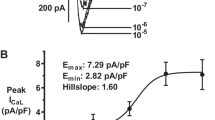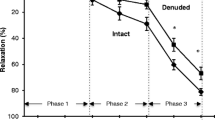Abstract
The aim of this study was to determine if adenosine exerts an anti-adrenergic effect on rabbit isolated atrioventricular (AV) nodal cells and, if so, the dependence of this effect on nitric oxide (NO) production. Inward Ca current,I Ca, was measured in AV nodal cells, enzymatically isolated from rabbit hearts. Isoprenaline (0.1 μM) increasedI Ca from 676 ± 59 to 1102 ± 86 pA (n = 25). This isoprenaline-induced increase inI Ca, (178 ± 15 % of control) was abolished in the presence of 10 μM adenosine (I Ca 100 ± 2 % of control,n = 9, P < 0.05). This effect of adenosine was completely blocked by the A1 receptor antagonist CPDPX (8-cyclopentyl 1, 3-dipropylxanthine, 0.1 μM). In cells pre-treated with the NO synthase inhibitor,l-nitro-arginine methyl ester (l-NAME, 1 mM) the isoprenaline-induced increase inI Ca(208 ± 39 % of control,n = 7) was not reduced by the addition of 10 μM adenosine (195 ± 32% of control). Co-incubation of cells inl-NAME withl--arginine (1 mM, the endogenous substrate of NO synthase) restored the adenosine-induced attenuation ofI Ca. In these cells, isoprenaline increasedI Ca (157 ± 7% of control,n = 6), and, following addition of adenosine (10 μM)I Ca was reduced to 107 ± 8% (P < 0.05). The NO-releasing agent SIN-1 (3-morpholino-sydnonimine, 100 μM) inhibitedI Ca augmented by isoprenaline (n = 5). It is concluded that adenosine exerts an anti-adrenergic effect on the AV node via A, receptors to attenuate a catecholamine-stimulated increase inI Ca and that this action involves the intracellular production of NO.
Similar content being viewed by others
References
Balligand JK, Kelly RA, Marsden PA, Smith TW, Michel T (1993) Control of cardiac muscle cell function by an endogenous nitric oxide signalling system. Proc Natl Acad Sci USA 90:347–351
Belardinelli L, Linden J, Berne RM (1989) The cardiac effects of adenosine. Prog Cardiovasc Dis 32:73–97
Cerbai E, Klockner U, Isenberg G (1988) Ca-antagonistic effects of adenosine in guinea pig atrial cells. Am J Physiol 255:H872-H878
Clemo HF, Belardinelli L (1986) Effect of adenosine on atrioventricular conduction. I: site and characterization of adenosine action in the guinea pig atrioventricular node. Circ Res 59:427–436
Fischmeister R, Hartzell HC (1987) Cyclic guanosine 3′,5′-monophosphate regulates the calcium current in single cells from frog ventricle. J Physiol (Lond) 387:453–472
Han X, Simoni Y, Giles WR (1994) An obligatory role for nitric oxide in autonomic control of mammalian heart rate. J Physiol (Lond) 476:309–314
Han X, Shimoni Y, Giles WR (1994) A cellular mechanism for nitric oxide-mediated cholinergic modulation of heart rate. J Physiol (Lond) 480:92P
Henrich M, Piper HM, Schrader J (1987) Evidence for adenylate cyclase-coupled A1-adenosine receptors on ventricular cardiomyocytes from adult rat and dog heart. Life Sci 41:2381–2388
Irasawa H, Brown HF, Giles WR (1993) Cardiac pacemaking in the sinoatrial node. Physiol Review 73:197–227
Isenberg G, Belardinelli L (1984) Ionic basis for the antagonism between adenosine and isoproterenol on isolated mammalian ventricular myocytes. Circ Res 55:309–325
Kurachi Y, Nakajima T, Sugimoto T (1986) On the mechanism of activation of muscarinic K+channels by adenosine in isolated atrial cells: involvement of GTP-binding proteins. Pflügers Arch 407:264–274
Levi RC, Alloatti G, Penna C, Gallo MP (1994) Guanylatecyclase-mediated inhibition of cardiacI Ca by carbachol and sodium nitroprusside. Pflügers Arch 426:419–426
Linden J, Hollen CE, Patel A (1985) The mechanism by which adenosine and cholinergic agents reduce contractability in rat myocardium. Correlation with cyclic adenosine monophosphate and receptor densities. Circ Res 56:728–735
Martynyuk AE, Kane KA, Cobbe SM, Rankin AC (1995) The role of nitric oxide production in the anti-adrenergic effect of adenosine on calcium current in isolated rabbit atrio-ventricular cells (abstract). Br J Pharmacol 114:271P
Martynyuk AE, Kane KA, Cobbe SM, Rankin AC (1995) Adenosine increases potassium conductance in isolated rabbit atrioventricular nodal myocytes. Cardiovasc Res (in press)
Mery PF, Pavione C, Belhassen L, Pecker F, Fischmeister R (1993) Nitric oxide regulates cardiac Ca2+ current. Involvement of cGMP-inhibited and cGMP-stimulated phosphodiesterases through guanylyl cyclase activation. J Biol Chem 268:26286–26295
Pelleg A, Belardinelli L (1993) Cardiac electrophysiology and pharmacology of adenosine: basic and clinical aspects. Cardiovasc Res 27:54–61
Rankin AC, Sitsapesan R, Kane KA (1990) Antagonism by adenosine and ATP of an isoprenaline-induced background current in guinea-pig ventricular myocytes. J Moll Cell Cardiol 22:1371–1378
Samet MK, Rutledge CO (1984) Antagonism of the positive chronotropic effect of norepinephrine by purine nucleosides in rat atria. J Pharmacol Exp Ther 323:100–110
Wahler GM, Dollinger SJ (1995) Nitric oxide donor SIN-1 inhibits mammalian cardiac calcium current through cGMPdependent protein kinase. Am J Physiol 268:C45-C54
West A, Isenberg G, Belardinelli L (1986) Antagonism of forskolin effects by adenosine in isolated hearts and ventricular myocytes. Am J Physiol 250:H769-H776
West A, Tewari K, Winn HR, Simard JM (1994) Adenosine decreases single channel calcium current in cerebral arteriolar smooth muscle cells(abstract). Drug Dev Res 31:P333
Author information
Authors and Affiliations
Rights and permissions
About this article
Cite this article
Martynyuk, A.E., Cobbe, S.M., Rankin, A.C. et al. Nitric oxide mediates the anti-adrenergic effect of adenosine on calcium current in isolated rabbit atrioventricular nodal cells. Pflugers Arch. 431, 452–457 (1996). https://doi.org/10.1007/BF02207285
Received:
Accepted:
Issue Date:
DOI: https://doi.org/10.1007/BF02207285




